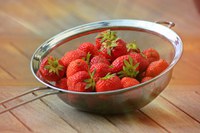Prairie Fare: Enjoy Seasonal Strawberries
(Click an image below to view a high-resolution image that can be downloaded)
By Julie Garden-Robinson, Food and Nutrition Specialist
NDSU Extension
I remember the “you-pick” strawberry patches we would visit in the early summer when I was a kid.
You could see the plump, red berries peeking out from under the green foliage. I thought walking down the rows in a large field of strawberries was fun.
I also remember a lady in a broad-brimmed floppy hat who sat in a high lifeguard-style chair peering out at all of us. We were crawling on our knees along the rows and putting berries into crates and buckets.
“Do not eat berries while you pick!” she’d yell gruffly on occasion.
She was the “berry guard,” I guess.
As a 10-year-old, I was very obedient and I didn’t eat one strawberry. However, I saw adults discreetly popping berries in their mouths, which were hidden by their equally floppy hats.
Despite the scarecrows flapping in the breeze, many birds were flying around the fields and nipping at the berries. I could feel the sandiness on the berries on my hands.
Besides the yelling lady, the combination of potential bird waste and sandy grit also were deterrents to my tasting. Before we began picking, my mother told me not to eat berries that hadn’t been rinsed.
That meant “do not eat any berries in the field.”
My aunt helped us pick berries one year. When we brought our 25 buckets of berries to settle our bill with the owner, my aunt said she only needed one bucket.
I knew what I’d be doing when we arrived home. I was the “huller,” so I used a little tool to remove the leafy end cap and core. By the time I was done rinsing and hulling 24 buckets of berries, the skin on my fingers was shriveled.
My skin also turned grayish from the reaction of the metal in the tool and the acid in the strawberries. My elephant-colored hands eventually returned to normal; however, I wasn’t interested in eating strawberries for a while.
Strawberries are perishable, so we needed to begin the preservation process quickly. Strawberries are “in season” in the spring and summer. This is when strawberries are at peak quality and, usually, a lower price in grocery stores and at farmers markets.
When buying strawberries, look for fruits that are bright red with green caps and are free from moisture or bruising.
Many varieties of strawberries are available, but only some are suitable for North Dakota’s growing conditions. Strawberries are available as ever-bearing and June-bearing.
Ever-bearing plants produce a crop in late June and early July, with a second lighter crop in late summer. They continue producing until freeze-up if the conditions are favorable. Two ever-bearing varieties recommended for general planting are Ft. Laramie and Ogallala.
June-bearing strawberry plants produce their entire crop between mid-June and mid-July. Recommended June-bearing varieties include AC Wendy, Annapolis, Honeoye, Glooscap, Mesabi and Sparkle.
The best time to plant strawberries is in early spring, but they can be planted into late summer.
For more information on planting and growing strawberries, visit https://www.ag.ndsu.edu/publications/food-nutrition/strawberries-1 to view the North Dakota State University Extension publication “Strawberries.”
Fresh strawberries should be stored in the crisper drawer of a refrigerator. Rinse berries with cool running water just before eating them to delay spoilage. Handle gently to avoid bruising the strawberries.
You can preserve berries by freezing, drying, and making jams and jellies to enjoy all year long.
One cup of strawberries has about 55 calories. Strawberries are an excellent source of vitamin C and a good source of folate, potassium and fiber.
Strawberries are one of the specialty crops that can be grown in North Dakota. Visit NDSU Extension’s Field to Fork website at https://www.ag.ndsu.edu/fieldtofork and click on “Learn More about N.D. Specialty Crops” for information about growing, preparing and preserving a variety of locally grown produce, including strawberries.
Here’s a delicious berry recipe for any time of year. Instead of using an oven, keep your slow cooker in use this summer. Slow cookers keep your kitchen cool and use less energy than ovens.
Slow Cooker Berry Cobbler
2 1/2 c. all-purpose flour, divided
1 1/4 c. granulated sugar, divided
2 tsp. baking powder
1/2 tsp. ground cinnamon
2 eggs
1/2 c. whole milk
1/4 c. canola oil
1/8 tsp. salt
4 c. frozen mixed berries, your preference
In a large bowl, combine 2 cups flour, 1/4 cup sugar, baking powder and cinnamon. Add the eggs, milk and oil, and stir until moistened (batter will be thick). Coat the slow cooker with cooking spray. Spread batter evenly into slow cooker. In a separate large bowl, combine the salt, remaining flour and sugar. Add berries and toss to coat. Pour on top of the batter in the slow cooker. Place the lid on the slow cooker and cook on high for three hours or until a toothpick inserted into the cobbler comes out clean. Serve immediately.
Makes eight servings. Each serving has 370 calories, 9 grams (g) fat, 69 g carbohydrate, 6 g protein and 200 milligrams sodium.
(Julie Garden-Robinson, Ph.D., R.D., L.R.D., is a North Dakota State University Extension food and nutrition specialist and professor in the Department of Health, Nutrition and Exercise Sciences. Follow her on Twitter @jgardenrobinson)
NDSU Agriculture Communication - June 6, 2019
| Source: | Julie Garden-Robinson, 701-231-7187, julie.garden-robinson@ndsu.edu |
|---|---|
| Editor: | Ellen Crawford, 701-231-5391, ellen.crawford@ndsu.edu |



